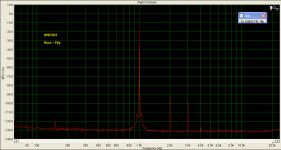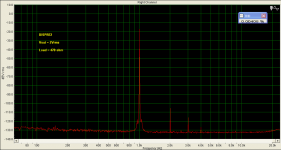John -
I only wanted to off-load PMA from too much simulation work. Sure, let's see what PMA can do.
If you need my help, let me know, and I will do the simulations.
My email is also available.
Sigurd
I only wanted to off-load PMA from too much simulation work. Sure, let's see what PMA can do.
If you need my help, let me know, and I will do the simulations.
My email is also available.
Sigurd
john curl said:Sigurd, there is no real secret here, as most of the toplogies are already on this thread somewhere. Let's see what PMA can do first, since he put up the topologies and has them handy. You could always go to his website and get them, if you wish.
Bob Cordell said:
Hi PMA,
Could you please elaborate on why you believe the asymmetrical LTP/VAS I described and use is inferior to the full complementary dual differential pair approach? I believe it is actually superior.
Bear in mind that the approach I am referring to provides full complementary push-pull operation of the VAS (unlike what you may be referring to in referencing Self).
The generic structure I am referring to starts with an N-channel JFET diff pair that is differentially loaded. It feeds a PNP differential pair. One output of that pair drives the top of the bias spreader. The other output drives a current mirror which functions as the NPN part of the VAS, driving the bottom of the bias spreader. The detailed arrangement is documented in my MOSFET power amp paper on my web site at www.cordellaudio.com. That arrangement provides exceptionally low distortion in that amplifier of 0.0006% THD-20 at full power.
Are we talking about the same arrangement?
If we are, could you be more specific about your objections to it?
Thanks,
Bob
Hi Pavel,
Perhaps you missed this question, as I haven't seen a reply.
I've since checked the section in Self you referred to, and it is really only very cursory treatment of complementary VAS achieved with a unipolar input stage. You're right, he is not a fan of the use of a complementary VAS. I am.
I also checked your web site and did not see any elaboration on your opinion of using a unipolar input stage to drive a complementary VAS.
Anyway, if you could elaborate on specifically why you think that approach is inferior to the full complementary dual-differential input/VAS arrangement I would appreciate it.
Cheers,
Bob
PMA said:Simple differential:
Notice that while the overall distortion is higher, the distortion products are monotonic.
Isn't this what Hiraga and others have said is preferable?
So how about the same using Ge transistors?
se
Steve Eddy said:
Isn't this what Hiraga and others have said is preferable?
No. Also high order are higher.
PMA said:
No? Mmmm. I'm pretty sure that's what Hiraga advocated. I'll see if I can find something more specific.
Also high order are higher.
Even products are higher. Odd products are all about the same.
So do you have any Ge SPICE models?
se
john curl said:So, is Hiraga the guru to follow here?
I don't know. What guru would you suggest be followed?
se
He is a pretty good audio designer. He first discovered differences in wire, and wrote the first real article with measurements included back, in the 1970's. I met him in 1978 and he even sold me a little phono preamp, Would you like to buy it, or copy it? You never know, it might be near perfect. It is built like a bird cage in construction.
SE, you can follow his directives if you wish, but PMA and I would prefer to reduce the higher order distortion to virtual unmeasurability, even at the cost of slightly more 2'd or 3'rd harmonic, if necessary.
This follows earlier work from the 1930's-1940's, as described in 'The Radiotron Designers Handbook' that makes more complete sense to me.
SE, you can follow his directives if you wish, but PMA and I would prefer to reduce the higher order distortion to virtual unmeasurability, even at the cost of slightly more 2'd or 3'rd harmonic, if necessary.
This follows earlier work from the 1930's-1940's, as described in 'The Radiotron Designers Handbook' that makes more complete sense to me.
john curl said:I met him in 1978 and he even sold me a little phono preamp, Would you like to buy it, or copy it? You never know, it might be near perfect. It is built like a bird cage in construction.
I don't know. The "built like a bird cage in construction" has me at least a little intrigued. Can you manage a photo?
SE, you can follow his directives if you wish, but PMA and I would prefer to reduce the higher order distortion to virtual unmeasurability, even at the cost of slightly more 2'd or 3'rd harmonic, if necessary.
Well in the sims at least, the highest product, the 7th, is the same in both instances so there's no apparent advantage in that regard. So I guess it just remains whether or not it would be preferable to have the products fall off monotonically with even order dominance or not with odd order dominance.
This follows earlier work from the 1930's-1940's, as described in 'The Radiotron Designers Handbook' that makes more complete sense to me.
Wasn't there ultimately a monotonic weighting applied? That the third should be lower than the second, the fourth lower than the third, the fifth lower than the fourth, etc.?
se
Steve Eddy said:
So do you have any Ge SPICE models?
se
Steve, I am not interested in doing Ge simulations. My work - my time, not yours.
Also, I have to apologize to those I do not answer, my free time is really not unlimited to be spent all in high-end chat.
Unlike me, PMA. 
I think the example would be more clear if and when you can go back to fets as an input. There, the differences should be more pronounced, expecially with high drive.
I agree, Ge, would be interesting, but you have to get good models first. Let SE do it, he is the resident expert around here, certainly he can SPICE something together.

I think the example would be more clear if and when you can go back to fets as an input. There, the differences should be more pronounced, expecially with high drive.
I agree, Ge, would be interesting, but you have to get good models first. Let SE do it, he is the resident expert around here, certainly he can SPICE something together.
PMA said:Steve, I am not interested in doing Ge simulations. My work - my time, not yours.
Fine. I never claimed it was mine. No need to get so defensive.
I just thought it would be interesting as some are of the opinion that germanium transistors sound better than silicon transistors.
se
john curl said:I agree, Ge, would be interesting, but you have to get good models first. Let SE do it, he is the resident expert around here, certainly he can SPICE something together.
Well, as you say, you'd first have to get good models.
Better perhaps just to build.
If you can recommend a complementary pair of germanium transistors that would be a good candidate for this, I'll see if I can't hunt them down. If SY's up to it, I could build it and send it on over to him for distortion analysis.
se
 Lots of OT posts deleted. If someone wants to start a separate thread on wire and diodic effects, feel free.
Lots of OT posts deleted. If someone wants to start a separate thread on wire and diodic effects, feel free.SY said:Lots of OT posts deleted.
FASCIST PIG! 😀
So if I build up a double complementary germanium input stage, would you care to run a distortion analysis on it?
se
SY said:I'd be happy to, but I'm only confident to the -100dB level.
Well, unless someone else volunteers, that's fine.
se
- Status
- Not open for further replies.
- Home
- Amplifiers
- Solid State
- John Curl's Blowtorch preamplifier

